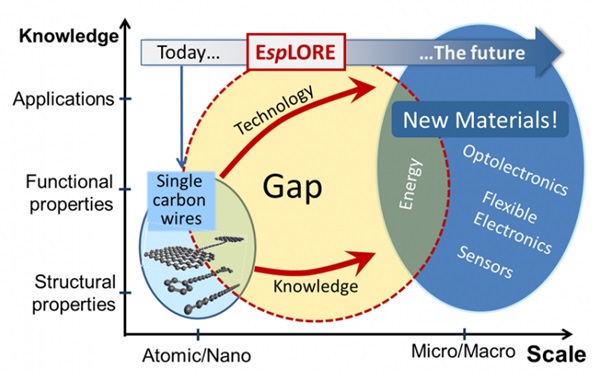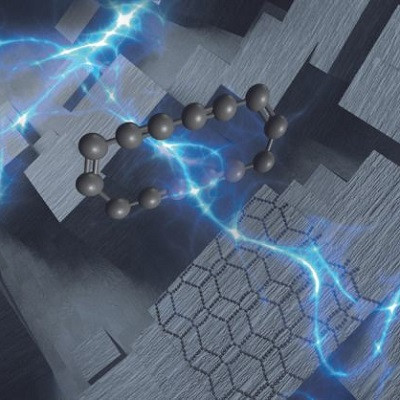EspLORE is a €2 million funded project which is coordinated and operated by Politecnico di Milano University. The project aims at filling the large existing gap between the present knowledge of carbon-atom wires (CAWs) as isolated structures and the potential applications of new functional CAW-based materials in an engineering-oriented approach.
The core concept of EspLORE is to explore the applied science and engineering of new materials in the form of thin films and nanocomposites comprising or assembled from these structures. The main envisaged applications are in the field of direct energy conversion devices (e.g., photovoltaics, fuel cells, water splitting) but can also include electronics, optoelectronics, sensors and functional coatings.

Carbon-atom wires, based on sp hybridization, are one-dimensional carbon nanostructures with functional properties strongly dependent on the wire length and termination. The design and control of the wire structure opens the way to building materials with tunable properties, which is at present a largely unexplored topic.
The main goals of the EspLORE project are:
1- Controlled synthesis of wires:
The activity was focused on the synthesis of carbon atomic wires by means of physical techniques such as pulsed laser ablation in liquids (PLAL) and arc discharge in liquids (SADL). PLAL is used for its versatility in the choice of the target materials and SADL for its scalability and low cost. The main objective is the control of wire length and termination.
2- Development of strategies to assemble wires in thin films and nanocomposites:
This activity is focused on investigating the fabrication of materials assembled from carbon wires. The main objective is to produce a solid-state material in the form of a film or a coating and to investigate how and to what extent its properties are affected and/or modulated by the properties of individual carbon wires employed in the material. The research deals with the instability problem in linear chains (or atomic wires) of carbon: in nature, they tend to degrade, becoming amorphous carbon for example. This limited stability prevents the use of the applied spin-offs these one-dimensional nanostructures could have in the materials engineering field. EspLORE has developed nanocomposites consisting of a polymer matrix embedding carbon wires. Carbon wires in such nanocomposites show prolonged stability in time, much higher than in liquid.
"Finding new methodologies to stabilize these chains in a solid material allows us to start assessing still-unexplored potential applications", explains professor Casari at the NanoLab (Micro and Nanostructured Materials Laboratory) of the Department of Energy, Politecnico di Milano.
3- Exploration of potential use of wire-based materials in direct energy conversion devices (e.g., photovoltaics, water splitting, fuel cells):
The proposed methodology includes fabrication of wires by physical methods, their deposition/ assemblage on surfaces, and the experimental study of structural, electronic and optical properties. The outcomes of the project (including 11 articles) will put the foundations for the materials engineering of wire-based systems and their realistic implementation in advanced technological applications. These materials, able to provide complementary properties to graphene, will synergistically contribute to opening new perspectives for an innovative ”all-carbon” approach to present and future challenges in many fields of engineering and technology.
In many technological fields, the availability of radically new materials could be a key step to developing new solutions in a revolutionary way. From electronic to energy conversion and storage devices, new materials could overcome present limitations, with new functionalities and enhanced performances.
